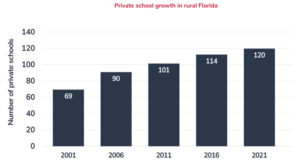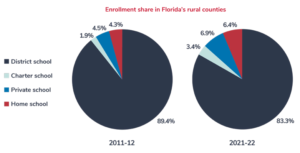A new study from Step Up for Students allays concern that school choice won’t work in rural areas. The study of 30 rural Florida counties confirms that school choice enrollment is growing in rural Florida and that more options are available.
Its findings include:
- In 2021-22, 16.7 percent of students in Florida’s 30 rural counties attended something other than a district school, whether a private school, charter school or home education. That’s up from 10.6 percent a decade prior.
- The number of private school choice scholarships increased from 1,706 to 6,992 over the last decade.
- The number of private schools in Florida’s rural counties jumped from 69 to 120. Even in the most sparsely populated counties, choice is enabling supply to meet demand.
And even though private school enrollment share in Florida’s rural counties rose from 4.5% to 6.9%, total enrollment in rural district schools grew by 3.3%.
Fear that choice doesn’t work for rural students is a consistent topic in Kansas, and it was a major issue in the latest campaign cycle in Oklahoma. A recent story by the Oklahoma Council of Public Affairs Center for Independent Journalism says choice opponents repeatedly claimed that allowing education funding to stay with the student would destroy rural schools and produce no benefit for most rural students.
“Having just gone through a campaign cycle where school choice was a major issue in statewide races in Oklahoma, and the potential impact of school choice in rural areas was a major attack lobbed by opponents, the study from Step Up for Students was of great interest to us at OCPA,” Center for Independent Journalism Director Ray Carter said via email. “Since Florida has had significant school-choice programs in place much longer than most states, it provides a good view of the long-term impact of those programs. That school choice had not harmed rural areas in Florida, and instead increased opportunity, was not surprising, but we felt the study was worth highlighting because it provided the real-world data that often matters most to policymakers.”
“It’s a myth repeated so often, and for so long it’s come to be accepted as fact: School choice won’t work in rural areas,” wrote Ron Matus and Dava Hankerson, both officials with Step Up for Students. “But just like so many other myths about school choice — that it destroys traditional public schools, that it doesn’t lead to better academic outcomes, that it lacks accountability — the myth about school choice not working in rural areas doesn’t stand up to scrutiny.”

The study found that — not only has school choice not significantly impacted public schools — it has actually improved outcomes.
According to Education Week, Florida now ranks No. 3 in the nation in K-12 achievement and has ranked in or near the Top 10 for a decade.
Florida also now ranks No. 1, No. 1, No. 3, and No. 8 on the four core tests of the National Assessment of Educational Progress, once adjusted for demographics. NAEP is considered the gold standard for standardized tests.
Additionally, Florida ranks No. 2 in the nation in the percentage of seniors who have passed Advanced Placement exams — while having a higher rate of low-income students than every state but one in the Top 10, and Florida’s high school graduation rate was 52 percent in 1998 and is 90.1 percent today.
“There are so many positive testimonials about education choice in rural Florida, in fact, that it’s befuddling to hear choice opponents in Texas, Oklahoma, Iowa, and other states continue to make the same, contradictory claims: 1) that school choice won’t do any good for rural areas, because there are so few options to give rural parents a choice, and 2) that it will decimate rural district schools,” Matus and Hankerson wrote. “School choice doesn’t make the sky fall on rural district schools. But it does help part the clouds for rural families who need options for their children.”
Perpetually low achievement in Kansas and school managements’ refusal to address the crisis is explored in Giving Kids a Fighting Chance with School Choice.



